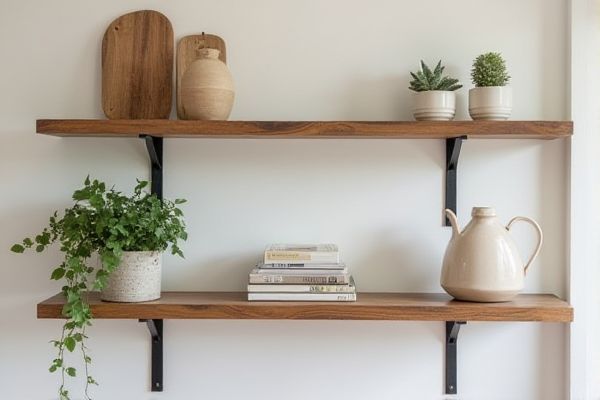
Floating shelves offer a sleek, modern look by concealing mounting hardware, creating an illusion of shelves that "float" on your wall, while bracketed shelves provide visible support through decorative or functional brackets, enhancing stability for heavier items. Explore the rest of the article to discover which shelving option best suits your space and style needs.
Table of Comparison
| Feature | Floating Shelves | Bracketed Shelves |
|---|---|---|
| Appearance | Minimalist, hidden mounting | Visible brackets, traditional look |
| Installation | More complex, requires precise mounting | Easy, brackets screwed into wall |
| Load Capacity | Moderate, depends on internal supports | High, brackets provide strong support |
| Maintenance | Harder to adjust or repair | Easy to adjust or replace brackets |
| Cost | Generally pricier due to design | Affordable, standard hardware |
| Best Use | Modern, sleek interiors; light to medium loads | Versatile for heavy items; casual or traditional spaces |
Introduction to Floating and Bracketed Shelves
Floating shelves offer a sleek, minimalistic look by concealing all mounting hardware within the shelf itself, creating a clean, modern aesthetic ideal for contemporary interiors. Bracketed shelves rely on visible metal or wooden supports that attach to walls, providing strong support suited for heavy items and adding a decorative element to room design. Both shelf types vary in weight capacity, installation complexity, and style, influencing choice based on functionality and visual preference in home organization.
Design and Aesthetic Appeal
Floating shelves offer a sleek, minimalist design that creates a clean, uncluttered look by hiding all hardware for a seamless appearance. Bracketed shelves, on the other hand, showcase visible supports that can add a rustic or industrial charm, making them a focal point in your room's decor. Choosing between the two depends on your preference for either modern subtlety or bold decorative elements.
Installation Process and Requirements
Floating shelves require wall anchors and a stud for secure mounting, involving concealed brackets that create a sleek, minimalistic look, while bracketed shelves need visible metal or wooden supports attached directly to studs or using heavy-duty anchors. Installation of floating shelves demands precise measurements and level alignment to ensure stability without external support, often requiring a drill, screws, and a stud finder. Bracketed shelves offer a simpler installation with fewer alignment constraints, making them ideal for heavier loads or DIY beginners.
Weight Capacity and Stability
Floating shelves offer a sleek, minimalist design but generally support less weight, typically ranging between 15 to 50 pounds depending on wall anchors and materials. Bracketed shelves provide enhanced stability and higher weight capacity, often supporting 50 to 150 pounds or more due to visible, sturdy metal or wooden brackets reinforcing the structure. Your choice should consider the weight of the items to be displayed, with bracketed shelves being ideal for heavy books or equipment, whereas floating shelves suit lighter decorative objects.
Space Utilization and Versatility
Floating shelves offer sleek space utilization by mounting flush against walls, making them ideal for minimalist interiors and maximizing floor area. Bracketed shelves provide enhanced versatility with adjustable supports that can accommodate heavier items and customizable configurations to fit varying storage needs. Choosing the right option impacts your room's functionality and design flexibility based on how you plan to use the available space.
Material Options and Durability
Floating shelves often feature materials like engineered wood, MDF, or metal, prized for sleek, minimalistic designs but can vary in durability based on mounting hardware and wall strength. Bracketed shelves commonly use solid wood, metal, or glass, offering superior load-bearing capacity and longer-lasting support ideal for heavier items. Your choice depends on required strength and aesthetic preference, with bracketed shelves generally providing enhanced durability for robust storage needs.
Cost Comparison: Floating vs Bracketed Shelves
Floating shelves typically cost more due to hidden mounting hardware and require precise installation, while bracketed shelves are generally more affordable with visible supports that simplify setup. Material choice and size influence price for both types, but bracketed shelves offer greater cost flexibility through a wide range of bracket styles and materials. You can optimize your budget by selecting bracketed shelves for budget-friendly options or investing in floating shelves for a sleek, modern look.
Maintenance and Longevity
Floating shelves offer a sleek design with concealed mounting, but they may require more careful weight distribution to maintain stability and prevent sagging over time. Bracketed shelves, supported by visible metal or wooden brackets, typically provide stronger, more durable support that can endure heavier loads and reduce the need for frequent adjustments or repairs. Choosing the right shelf depends on your maintenance preferences and the longevity required for your storage needs.
Best Applications for Each Type
Floating shelves are best suited for minimalist and modern interiors where a clean, seamless look is desired, ideal for displaying lightweight decor items or small plants in living rooms and bedrooms. Bracketed shelves excel in functionality and strength, making them perfect for heavy storage in kitchens, garages, or offices, where durability and load capacity are priorities. Choosing between floating and bracketed shelves depends on whether aesthetics or weight-bearing capacity is the primary concern in the space.
Choosing the Right Shelf for Your Space
Floating shelves offer a sleek, minimalist look ideal for modern interiors and small spaces, as they appear to "float" without visible supports, maximizing floor space and creating a clean aesthetic. Bracketed shelves provide robust support for heavier items and a more traditional or industrial style, making them suitable for storage in kitchens, garages, or offices where durability is prioritized. Selecting the right shelf depends on the weight capacity needed, desired visual impact, and the specific functional requirements of the room.
 homyna.com
homyna.com